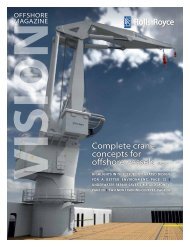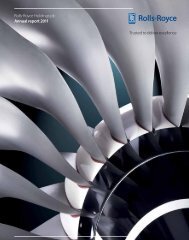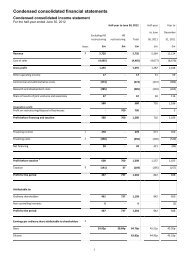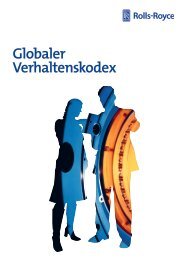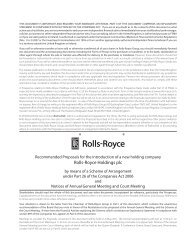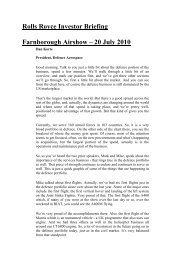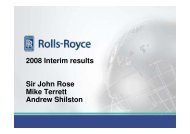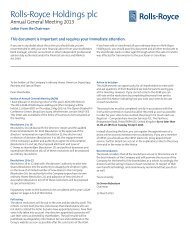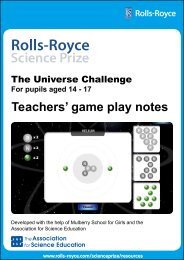Teachers' extension activities - Rolls-Royce
Teachers' extension activities - Rolls-Royce
Teachers' extension activities - Rolls-Royce
Create successful ePaper yourself
Turn your PDF publications into a flip-book with our unique Google optimized e-Paper software.
The Universe Challenge<br />
For pupils aged 14 - 17<br />
Teachers’ <strong>extension</strong> <strong>activities</strong><br />
Developed with the help of Mulberry School for Girls and the<br />
Association for Science Education<br />
www.rolls-royce.com/scienceprize/resources
Universe Challenge<br />
Objectives<br />
Background<br />
In 2007 Mulberry School for Girls, London, won the runner-up award in the <strong>Rolls</strong>-<strong>Royce</strong> Science Prize<br />
with a project called the Universe Gallery.<br />
The team’s aim was to bring science to the heart of the school by producing a timeline of the history<br />
of the Universe down the length of a corridor. The timeline formed the basis of a series of learning<br />
opportunities<br />
Activities<br />
that are explained in the following notes. Full details of the project can be found on the<br />
<strong>Rolls</strong>-<strong>Royce</strong> Science Prize website: www.rolls-royce.com/scienceprize<br />
Several of the projects were collaborations with external practitioners. The Arts Catalyst, a<br />
science-art agency and other partner organisation provided introductions to practitioners, expertise<br />
and support throughout the project. See www.artscatalyst.org for more information about their work.<br />
The project objectives were to:<br />
Build a vibrant and active learning environment which emphasises that learning goes on<br />
outside the classroom<br />
Promote a sense of awe, wonder and respect for the Universe through enhanced scientific<br />
understanding<br />
Provide opportunities to reflect on the nature of creativity in the physical universe and to<br />
respond creatively<br />
Outcomes<br />
Facilitate participation of the whole school community<br />
Facilitate pupil creation and leadership of their own learning opportunities<br />
Notes<br />
National Curriculum Links<br />
www.rolls-royce.com/scienceprize/resources
Red shift:<br />
How do we know what we know?<br />
Objectives<br />
Explore ways of demonstrating the red shift of light from distant galaxies<br />
Reflect on the nature of our information about the Universe<br />
Gain practical skills in electronics<br />
Activities<br />
Darken the room and provide an audio-visual stimulus for reflection as students enter e.g.<br />
www.hubblesite.org/gallery/movie_theater<br />
Use stimulus material to discuss the red shift and wavelengths of light, drawing attention to the vast distances<br />
and time scales involved.<br />
Discuss how this could be shown visually. Introduce the idea of using LEDs. This could also generate discussion<br />
about the nature of light as both photon and wave – the LEDs representing the particulate nature.<br />
Pupils use red and blue LEDs to make a visual display which will inspire thinking about the red shift. LEDs are<br />
wired together and fixed inside trunking which will run the length of the science corridor, from big bang to formation<br />
of the Earth. LEDs are blue and close together at the big bang end and red and further apart at the Earth end.<br />
Students:<br />
Calculate the number of LEDs required and how far apart they will be<br />
Establish how the circuits will work, wire LEDs together, drill holes in plastic trunking<br />
and mount the LEDs<br />
Outcomes<br />
Notes<br />
Experience working collaboratively with adults and each other<br />
Use visual, auditory and kinaesthetic means to understand some big ideas<br />
Work practically with electronics<br />
Revise ideas about circuits<br />
This display does not provide an accurate scientific model. It does provide a visual stimulus to thinking and<br />
imagination.<br />
Engage external practitioners (artist, electronics expert, electrician, school premises manager, senior leadership)<br />
to enable pupils to experience the collaborative nature of building an installation for their school.<br />
National Curriculum Links<br />
Art & Design Especially 3.b exploration of media, processes and techniques in 2D, 3D and new technologies<br />
4g make links between art and design and other subjects and areas of the curriculum.<br />
Science KS3 Especially 3.4b astronomy and space science provide insight into the nature and observed motions<br />
of the sun, moon, stars, planets and other celestial bodies.<br />
Science KS4 Especially 2.4c the solar system is part of the Universe, which has changed since its origin and<br />
continues to show long-term changes.<br />
D&T Especially 3 n,o,p. the practical application of systems and control in design proposals electrical, electronic,<br />
mechanical, microprocessor and computer control systems and how to use them effectively using systems and<br />
control to assemble sub systems into more complex systems.<br />
www.rolls-royce.com/scienceprize/resources
Information panels:<br />
Collaboration with ICT<br />
Objectives<br />
Explore the key processes and events in the history of the Universe<br />
Present and display information in an engaging and accessible way<br />
Use ICT creatively<br />
Activities<br />
This can be set up as a competition between small groups or classes. Explain that the best pieces<br />
of work will be professionally produced to make a unified series of information panels describing<br />
the history of the Universe. Introduce the topics and themes. These could include:<br />
Big bang<br />
Red shift<br />
Absorption spectra<br />
Distance and size in the Universe<br />
Galaxies<br />
Stars<br />
Supernova<br />
Tiamat (supernova which gave birth to our Sun)<br />
Sol<br />
Solar system<br />
Challenge pupils to include representations of the idea of a billion in their displays e.g. What is the<br />
mass of a billion grains of rice? How far would you go if you walked a billion metres?<br />
Pupils use ICT programs to produce their presentations. The best presentations are produced as<br />
large displays on foam board.<br />
Outcomes<br />
Research a topic in depth<br />
Work collaboratively to present learning<br />
Develop their ICT skills<br />
National Curriculum Links<br />
Art & Design especially 3.b exploration of media, processes and techniques in 2D, 3D and new<br />
technologies.<br />
4g make links between art and design and other subjects and areas of the curriculum.<br />
Science KS3 especially 3.4b astronomy and space science provide insight into the nature and<br />
observed motions of the sun, moon, stars, planets and other celestial bodies.<br />
Science KS4 especially 2.4c the solar system is part of the Universe, which has changed since its<br />
origin and continues to show long-term changes.<br />
Maths KS4 3.1 Number and algebra real numbers, their properties and their different representations<br />
rules of arithmetic applied to calculations and manipulations with real numbers, including standard<br />
index form and surds.<br />
www.rolls-royce.com/scienceprize/resources
Gravity and the fabric of spacetime:<br />
Collaboration with external practitioner<br />
Objectives<br />
Create a visual display to stimulate thinking about general relativity<br />
Provide opportunities for students to engage with scientific ideas which are beyond the<br />
curriculum<br />
Activities<br />
Discuss the strangeness of Einstein’s ideas of gravity and spacetime. Show images of the warps in<br />
spacetime caused by large masses e.g. ‘A new picture of gravity’<br />
www.pbs.org/wgbh/nova/elegant/program.html<br />
Encourage students to use their imagination to visualise ways of presenting this:<br />
Use wire netting, then add balls of different sizes to distort it. Write small chunks of<br />
explanatory text – some pieces on paper and some written on mirrors with lipstick. Attach the<br />
pieces of text to the netting. Viewers can see themselves as part of the Universe in the<br />
mirrors<br />
Knit some fabric with very large needles (10cm or more in diametre) and fluorescent<br />
material<br />
Outcomes<br />
Notes<br />
Use visualization and imagination in a scientific context<br />
Produce a high quality display piece which ‘works’ as both science and art<br />
A text that could be used:<br />
‘Isaac Newton unified the heavens and the Earth by proposing that the same force that makes an apple fall<br />
also keeps the planets in orbit around the Sun. This idea was radical! It worked for 250 years. It still works<br />
today for launching rockets and landing people on the Moon.<br />
There was a problem though. Newton failed to suggest a mechanism of action for gravity. Albert Einstein was<br />
not happy about this. He also realised that gravity could not act instantaneously as Newton assumed, because<br />
nothing can travel faster than the speed of light, not even a force.<br />
So Einstein came up with a new picture. He imagined three dimensions of space and one of time as somehow<br />
unified in a fabric of spacetime. Like netting or knitting. Gravity is the warps and curves in this fabric caused by<br />
objects like planets, stars and black holes. We orbit the Sun because we are following a curve in<br />
spacetime caused by the Sun’s mass.’<br />
National Curriculum Links<br />
Art & Design especially 3.b exploration of media, processes and techniques in 2D, 3D and new<br />
technologies.<br />
4g make links between art and design and other subjects and areas of the curriculum.<br />
Science KS4 especially 2.4c the solar system is part of the Universe, which has changed since its<br />
origin and continues to show long-term changes.<br />
www.rolls-royce.com/scienceprize/resources
Sounds from the Stars:<br />
Collaboration with external practitioner<br />
Objectives<br />
Use principles of amplitude modulation to create a piece of artwork<br />
Learn principles and practice of electronics<br />
Facilitate learning through discussion<br />
Activities<br />
Explain amplitude modulation (that sound can be transmitted using light) by demonstrating sending<br />
music along a laser beam. Students use this principle to transmit recordings through LEDs.<br />
Students paint a display board to represent the dust and gas in star-forming regions of the Universe,<br />
and drill many holes in the patterns of galaxies and constellations. Wire LEDs and resistors into loops<br />
(each loop represents a ‘channel’) and glue into the holes. Leave some holes empty so that when<br />
they are backlit the light shines through to look like stars. Record space sounds, interviews, talks,<br />
discussions, music, interviews etc. gathered from many subject areas. e.g. interviews with scientists<br />
about faith could be done in Religious Studies, and poems in English.<br />
Use a computer to edit the recordings. Connect sounds to the LED channels. Viewers pass a light<br />
sensor over the LEDs to hear the sounds.<br />
New recordings can be made by subsequent groups of pupils.<br />
Outcomes<br />
Gain expertise in electronics<br />
Research the history of the Universe and galaxy formation<br />
Deepen knowledge and engagement with physics through extended discussion<br />
Notes<br />
This project benefits from technical expertise and time investment. Local artist Antony Hall worked<br />
with a small group of students on a similar project with Mulberry School for Girls.<br />
National Curriculum Links<br />
Science KS4 2.3d radiations in the form of waves can be used for communication.<br />
Religious Education 1.5 Meaning, purpose and truth:<br />
Analysing and synthesising insights on ultimate questions that confront humanity.<br />
4i explore the connections between RE and other subject areas.<br />
www.rolls-royce.com/scienceprize/resources
Using film:<br />
Collaboration with external practitioner<br />
Objectives<br />
Explore ways of using film to show scientific ideas and student creativity<br />
Explore ways of using film to develop imagination<br />
Use display to stimulate thinking<br />
Activities<br />
Make films of ideas, experiments, new learning.<br />
For example:<br />
Add drops of food colouring to a ripple tank under different conditions and film the patterns<br />
Use text and image in the films rather than sound<br />
Collaborate with maths and ICT to explore fractal geometry<br />
Outcomes<br />
Present learning in a visual way<br />
Explore patterns, shape and form<br />
Create artworks<br />
Make a teaching and learning resource for the school<br />
Notes<br />
Set up a projection space in a public area of the school. This is a good way to transform an otherwise<br />
empty wall/ceiling/floor space. Films can be looped, and if they are silent, imagination and visual<br />
learning is encouraged.<br />
National Curriculum Links<br />
Art & Design especially 3.b exploration of media, processes and techniques in 2D, 3D and new<br />
technologies.<br />
ICT KS4 2.3 Communicating information:<br />
Use a range of ICT tools and media to share, exchange and present information effectively in a<br />
variety of contexts.<br />
Create quality solutions that show they have considered how the information should be interpreted<br />
and presented in forms that suit audience, purpose and content.<br />
www.rolls-royce.com/scienceprize/resources
Plasma screen<br />
Objectives<br />
Explore ways of using ICT to show scientific ideas and student creativity<br />
Explore ways of using ICT to develop imagination<br />
Use display to stimulate thinking<br />
Activities<br />
Make ICT presentations an integral part of schemes of work. Students can be responsible for<br />
programming.<br />
Outcomes<br />
Present learning in a visual way<br />
Develop ICT skills<br />
Take responsibility for display<br />
Notes<br />
Install a plasma screen in a public place in the science department. This is useful as a noticeboard<br />
and for quizzes etc. as well as display of work.<br />
National Curriculum Links<br />
Art & Design especially 3.b exploration of media, processes and techniques in 2D, 3D and new<br />
technologies.<br />
ICT KS4 2.3 Communicating information:<br />
Use a range of ICT tools and media to share, exchange and present information effectively in a<br />
variety of contexts.<br />
Create quality solutions that show they have considered how the information should be interpreted<br />
and presented in forms that suit audience, purpose and content.<br />
www.rolls-royce.com/scienceprize/resources
Satellites to measure the time and space<br />
of my Universe: Collaboration with external practitioner<br />
Objectives<br />
Investigate the use of satellites as a means of gathering information<br />
Find personal ways to reflect on the passage of time<br />
Establish an emotional/personal connection with scientific ideas and technology<br />
Activities<br />
An external practitioner worked with the students from Mulberry School for Girls on this project to<br />
share their professional experiences.<br />
Present images and explanations of different satellites and learn some names. Relate what satellites<br />
can do to personal experience of time and space.<br />
See notes below for a student description of the activity.<br />
Use student collages to make a large image using a computer.<br />
Outcomes<br />
Notes<br />
Learn what satellites do<br />
Reflect on the passing of time from a personal perspective<br />
Contribute to a collaborative artwork<br />
Mulberry School for Girls worked with Joanna Griffin. See her blog for details and images:<br />
www.aconnectiontoaremoteplace.net<br />
Here is an evaluation of the activity written by a year 7 student:<br />
‘Today’s science lesson was all about satellites and it was taught by an artist called Joanna. There are many<br />
satellites and they all have names. Two I have learnt are called COBE (Cosmic Background Explorer) and<br />
WMAP. They look like small, bright dots in the sky, but if you look at them properly they have straight things<br />
like wings poking out which have solar cells on them so they can use the sun’s energy. Our satellite dish that<br />
we installed at home to watch TV uses radio waves that come from the satellites in the sky. There are 6000<br />
satellites in the sky. After we learnt about the satellites, we discussed two questions. One was ‘How do we<br />
know time is passing?’ We came up with ideas like ‘we know time is passing when we get hungry, when we<br />
are growing up and when it’s sunrise and sunset’. The other one was to remember a happy memory in your<br />
life. One of my happy memories was when my niece was born and the first time I held and saw her. We had<br />
to then write answers to the two different questions on two different pieces of paper. Our next task was to cut<br />
lots of pictures and some words from science magazines along with the words we wrote, then stick them on<br />
a piece of paper to make a collage in the shape of a satellite, then decorate it. I took pictures of planets and<br />
solar systems and words like ‘Universe’ and ‘beautiful’. I found a small calendar in a magazine, therefore I<br />
stuck it on. I also put other pictures and words. I thought it was a very successful lesson as I finished a lot of<br />
work and learned quite a lot of information.’<br />
National Curriculum Links<br />
Science KS4 2.3d radiations in the form of waves can be used for communication.<br />
1.4 Applications and implications of science:<br />
Pupils should be taught about the use of contemporary scientific and technological developments<br />
and their benefits, drawbacks and risks.<br />
www.rolls-royce.com/scienceprize/resources
Timeline:<br />
Collaboration with external practitioner<br />
Objectives<br />
Make a timeline to show the nine billion years from the Big Bang to formation of the Sun and<br />
Earth<br />
Make links between science and art <strong>activities</strong><br />
Demonstrate that our information about the Universe comes from electromagnetic radiation<br />
Activities<br />
Provide stimulus material of clouds of gas and dust and galaxies e.g. Hubble images from:<br />
www.hubblesite.org<br />
Reflect on patterns. Use marbling techniques (add coloured inks to trays of water, then float cartridge<br />
paper on the water) to make patterns. Different colour-ranges can be used to provide images at the<br />
blue and red end of the spectrum. Use a computer to transform images from many students into<br />
coloured circles. Use these to make a wave pattern along the display space to represent the red shift<br />
– blue circles close together at the big bang end, red circles further apart at the sun end. Add text and<br />
numbers / times to show key events in the history of the Universe.<br />
Outcomes<br />
Notes<br />
Contribute to a collaborative artwork<br />
Reflect on the nature of science and art<br />
Reflect on how we know what we know about the Universe<br />
Mulberry School for Girls worked with Joanna Griffin on this project. See her blog for details<br />
and images: www.aconnectiontoaremoteplace.net<br />
National Curriculum Links<br />
Art & Design<br />
Especially 3.b exploration of media, processes and techniques in 2D, 3D and new technologies.<br />
4g Make links between art and design and other subjects and areas of the curriculum.<br />
www.rolls-royce.com/scienceprize/resources
The Universe story:<br />
Collaboration with storytellers and the Drama<br />
department<br />
Objectives<br />
Use storytelling and drama to present aspects of the history of the Universe and show how<br />
people have engaged with the Universe story<br />
Activities<br />
Give students a presentation/information on the story of the Universe as provided by science.<br />
Encourage students to research aspects of the story themselves. Teach important science facts such<br />
as the age of the Universe.<br />
Workshop some storylines. Students write and perform their own material.<br />
For example:<br />
The Restaurant at the End of the Universe. A primal star visits the restaurant and demands<br />
more and more food (hydrogen omelette, helium soufflé etc.) before going supernova and<br />
leaving the debris of larger elements all over the restaurant<br />
The story of the Reverend Robert Evans. An Australian priest and amateur astronomer who<br />
has discovered more supernovas than anyone else<br />
Outcomes<br />
Dr Who visits the Big Bang<br />
Develop knowledge of the history of the Universe<br />
Write and present their own material<br />
Develop confidence and ability to express complex ideas<br />
Notes<br />
Mulberry School for Girls worked with Alex Somerville on this project.<br />
See www.speakupstorytelling.com for storytelling by Alex Somerville<br />
National Curriculum Links<br />
English KS4 1.1 Competence<br />
Expressing complex ideas and information clearly, precisely and accurately in spoken and written<br />
communication.<br />
1.2 Creativity<br />
Making fresh connections between ideas, experiences, texts and words, drawing on a rich<br />
experience of language and literature.<br />
www.rolls-royce.com/scienceprize/resources
Space food:<br />
Collaboration with Food Technology<br />
Objectives<br />
Reflect on space travel and what and how astronauts eat<br />
Bake galactic food<br />
Activities<br />
Research and present what astronauts eat. Explore how the food is prepared.<br />
Make galactic food – baking star and spiral shapes etc. These can be preserved for display.<br />
Mulberry School for Girls held an opening event for the Universe Gallery, with external visitors. Food<br />
Technology students made the refreshments – sandwiches, savouries and sweets all with<br />
galaxy-themed shapes and decorations.<br />
Outcomes<br />
Take part in cross-curricular activity<br />
Research astronauts’ food requirements<br />
Contribute to a whole school event<br />
National Curriculum Links<br />
KS3 D&T<br />
3n How to prepare and assemble components to achieve functional results.<br />
KS3 Science<br />
3.3c Behaviour and health can be affected by diet.<br />
www.rolls-royce.com/scienceprize/resources
Cam toys:<br />
Collaboration with Technology<br />
Objectives<br />
Use science work on the Universe as the context for an established scheme of work in<br />
technology<br />
Learn about rotation and revolution through making mechanical toys<br />
Activities<br />
Make wooden cam toys and use the space theme to decorate them.<br />
Apply ideas of rotation and revolution to the solar system.<br />
Outcomes<br />
Think about their science work in technology<br />
Make toys to show ideas of rotation and revolution<br />
National Curriculum Links<br />
KS3 D&T<br />
3n How to prepare and assemble components to achieve functional results.<br />
www.rolls-royce.com/scienceprize/resources
Creation stories:<br />
Collaboration with English<br />
Objectives<br />
Consider how people of different traditions and at different times in history have thought<br />
about origins<br />
Read, present and perform stories from different traditions<br />
Consider similarities and differences between creation stories and the scientific theory of the<br />
history of the Universe<br />
Activities<br />
Present students with a range of creation stories from different cultures.<br />
Explain the scientific theory by personifying some of the key characters – stars, galaxies,<br />
supernovas etc.<br />
Students research and present stories in groups.<br />
Performances could be filmed for display.<br />
Outcomes<br />
Notes<br />
Consider the importance of story-making and story-telling in human culture<br />
Present their own versions of some creation stories<br />
Engage with the idea of science as inspiration for story-telling<br />
National Curriculum Links<br />
National English KS4 1.1 Curriculum Competence Links<br />
Expressing complex ideas and information clearly, precisely and accurately in spoken and written<br />
communication.<br />
1.2 Creativity<br />
Making fresh connections between ideas, experiences, texts and words, drawing on a rich experience<br />
of language and literature.<br />
www.rolls-royce.com/scienceprize/resources
Energy Transfers:<br />
Collaboration with Citizenship<br />
Objectives<br />
Calculate the energy transferred by lights, heating and appliances in part of the school<br />
Use an online carbon footprint calculator to work out carbon dioxide emissions<br />
Explore the advantages and disadvantages of carbon offset and emissions trading schemes<br />
Activities<br />
Teach P=IV. Students find out the power ratings of all appliances and length of time they are used<br />
for. Calculate energy transferred. Make comparisons with energy in food e.g. how many Mars Bar<br />
equivalents does the Science department consume each day?<br />
Use an online carbon calculator to find the carbon footprint. Calculate how many trees would have<br />
to be planted to offset the emissions.<br />
Mulberry School for Girls did this for the whole Universe Gallery, including LEDs, lighting for display<br />
cabinets, computers, projector and plasma screen. A group of students formed an Energy<br />
Committee and decided to raise funds for a tree-planting project in the Rift Valley in Kenya.<br />
Discuss climate change. Investigate ways the footprint could be reduced. Engage students in a<br />
debate about carbon offset schemes and emissions trading.<br />
Join the eco schools initiative: www.eco-schools.org.uk<br />
Outcomes<br />
Notes<br />
Gain a practical understanding of the effects of using electrical appliances<br />
Raise their awareness of the causes of climate change<br />
Take action to reduce emissions of greenhouse gases<br />
Engage with national and global initiatives<br />
National Curriculum Links<br />
National Curriculum Links<br />
Science KS4<br />
2.3 Energy, electricity and radiations.<br />
In their study of science, the following should be covered:<br />
Energy transfers can be measured and their efficiency calculated, which is important in considering<br />
the economic costs and environmental effects of energy use.<br />
www.rolls-royce.com/scienceprize/resources
Research into creativity in learning:<br />
Collaboration with Creative Partnerships (Creativity Action Research<br />
Awards) and the Sociology Department.<br />
Objectives<br />
Activities<br />
Activities<br />
Outcomes<br />
Notes<br />
Enable students to reflect on their learning and contribute to creation of their own learning opportunities<br />
Develop students’ research skills<br />
Find out about the nature of creativity and creative learning<br />
All or any of these projects could be the subject of an action research project on the nature of creativity<br />
in science.<br />
Mulberry School for Girls trained Sociology students in action research skills. They wrote, distributed<br />
and analysed questionnaires, and interviewed students.<br />
Film and photograph your work.<br />
Run a focus group to explore students’ perceptions of creativity in science and creative learning.<br />
Outcomes<br />
Notes<br />
Explore creative learning<br />
Gain research skills<br />
Contribute to the design of their own learning experiences<br />
Engage in meta-cognition of their learning<br />
See www.capeuk.org for more information on CAPE UK and creativity action<br />
research awards.<br />
See www.creative-partnerships.com for the work of Creative Partnerships.<br />
National Curriculum Links<br />
National Curriculum Links<br />
Citizenship<br />
3i Policies and practices for sustainable development and their impact on the environment.<br />
4j Make links between citizenship and work in other subjects and areas of the curriculum.<br />
www.rolls-royce.com/scienceprize/resources
Exploring beliefs and evidence about<br />
origins: Collaboration with Religious Studies<br />
Objectives<br />
Explore aspects of science and faith<br />
Participate in the dialogue between religious and scientific views about the origins of the Universe<br />
Develop and present arguments for particular viewpoints<br />
Engage with public figures from the worlds of science and religion<br />
Activities<br />
Activities<br />
The Science and Religion in Schools Project provides an excellent resource base: www.srsp.net<br />
Reframe the ‘science – religion debate’ as the ‘science-religion dialogue’.<br />
Invite scientists of various faiths or none to speak to students.<br />
Students interview scientists about their beliefs. They could make a film documentary, audio<br />
recording or podcast.<br />
Outcomes<br />
Outcomes<br />
Notes<br />
Become better informed<br />
Take part in debate<br />
Hear about a wide range of views<br />
Present their learning in a variety of ways<br />
National Curriculum Links<br />
Religious Education 1.5 Meaning, purpose and truth<br />
Analysing and synthesising insights on ultimate questions that confront humanity.<br />
4i Explore the connections between RE and other subject areas.<br />
www.rolls-royce.com/scienceprize/resources
Constellations:<br />
What are they?<br />
Objectives<br />
Learn to explore the night sky using tools such as Google Earth 4.2 and Celestia<br />
Understand how the orientation of constellations changes with viewing positions on Earth<br />
Understand that constellations are illusions caused by our position in the Universe and that<br />
they have been the source of imagery throughout history<br />
Activities<br />
Activities<br />
Build a model constellation using small spheres of aluminium foil hanging on threads. Use a<br />
constellation pattern to make holes in a card disc.<br />
See www.teachingk-8.com/archives/departments/integrating_science_in_your_classroom<br />
for ideas.<br />
Log on to Google Earth 4.2 or later and use the Sky button to explore the night sky and change the<br />
viewing position to see what the stars look like from other places on Earth.<br />
Study the history and imagery of constellations and create a display of images linked to constellations.<br />
Use the patters of constellations to invent new imagery that reflects our own culture.<br />
Outcomes<br />
Outcomes<br />
Use Google Earth and similar applications to explore the night sky<br />
Learn about the history and imagery of constellations<br />
Understand more about the geometry of the Universe<br />
Notes<br />
The Celestia and Orbiter applications require a high degree of familiarisation by teachers before<br />
offering as tools for students. Google is easier to use.<br />
National Curriculum Links<br />
Science KS4<br />
The solar system is part of the Universe, which has changed since its origin and continues to show<br />
long-term changes.<br />
www.rolls-royce.com/scienceprize/resources
Planet and star observation<br />
Objectives<br />
Understand how planets and stars differ in the night sky<br />
Explore animations of planetary orbits and their paths through the sky<br />
Activities<br />
Make simple observations of planets over a term or a year in relation to stars.<br />
Use the internet as an aid to find and identify planets using a compass.<br />
Use Google Earth to track planet paths in real time.<br />
Outcomes<br />
Notes<br />
Find and use astronomy websites with animations of planetary motion<br />
Discuss the ideas and language used in astrology<br />
Understand more about the geometry of the Universe<br />
Understand the optical difference between stars and planets<br />
Animations software applications require a high degree of familiarisation by teachers before offering<br />
as tools for students.<br />
National Curriculum Links<br />
Science KS4<br />
The solar system is part of the Universe, which has changed since its origin and continues to show<br />
long-term changes.<br />
www.rolls-royce.com/scienceprize/resources
Looking at Fraunhofer lines<br />
Objectives<br />
Understand some basic ideas about spectra-that light can be dispersed into the colours of the<br />
rainbow<br />
Explore Fraunhofer lines in sunlight-a rainbow with dark lines in it<br />
Activities<br />
Activities<br />
Look at sunlight through a pocket spectroscope and observe dark absorption lines.<br />
Look at light from an incandescent bulb and notice that there are no lines.<br />
Find stellar spectra online.<br />
Create a display of stellar spectra from web sites with notes on what the lines mean.<br />
Outcomes<br />
Outcomes<br />
Notes<br />
Notes<br />
Experience the fact that light from our Sun has gaps in its spectrum<br />
Relate this to spectra from other stars and appreciate that you need expensive instruments<br />
to measure such dim light<br />
Understand why astronomers look at spectral “fingerprints” from stars<br />
These topics might normally be regarded as advanced for KS4. However the observation of gaps in<br />
sunlight is a simple direct experience that there is something strange about sunlight. The fact that the<br />
light from stars has the same strange lines is confirmation that stars are like our sun; they are made<br />
of the same stuff and are similarly hot. The red shift measurements made by astronomers use these<br />
spectral lines.<br />
Fraunhofer lines can be observed without looking directly at the sun, even on a cloudy day.<br />
There is a close match to new GCSE Physics syllabuses.<br />
National Curriculum Links<br />
Science KS4<br />
The solar system is part of the Universe, which has changed since its origin and continues to show<br />
long-term changes.<br />
www.rolls-royce.com/scienceprize/resources
Measuring the Moon and distance<br />
to stars<br />
Objectives<br />
Measure either the diameter of the Moon or the distance to the Moon using similar triangles<br />
Make parallax measurements and relate to astronomical parallax<br />
Activities<br />
Use a broom handle or metre rule to occlude the Moon with a small disc stuck at a known distance<br />
from your eye.<br />
Use the maths of similar triangles to work out the diameter of the Moon, given its distance from the<br />
Earth or vice versa.<br />
Learn about using parallax to measure distances and relate to astronomical parallax using the<br />
Earth’s movement over six months.<br />
Take photos of outdoor measurement <strong>activities</strong> and combine with geometrical drawings to create a<br />
display of “How we measured the Universe”.<br />
Outcomes<br />
Outcomes<br />
Notes<br />
Notes<br />
Learn that simple rough calculations can help understand the scales of the solar system<br />
Understand how astronomers work out distances using big triangles<br />
Using right angled triangles a distance can be measure to distant objects near the school or on<br />
playing fields. This can then be directly related to astronomical parallax measurements.<br />
These are normally regarded as advanced ideas, but the geometry is simple and can be modelled<br />
in the school grounds and locality.<br />
National Curriculum Links<br />
National Curriculum Links<br />
Science KS4<br />
The solar system is part of the Universe, which has changed since its origin and continues to show<br />
long-term changes.<br />
Maths KS4<br />
3.2 Geometry and measures properties and mensuration of 2D and 3D shapes.<br />
www.rolls-royce.com/scienceprize/resources
Space technology time line<br />
Objectives<br />
Create a time line display of space history and space future<br />
Activities<br />
Research the history of space travel using the internet. Create a display using archive news graphics.<br />
Make a Sputnik model.<br />
Use prints to create a wall time line that runs into the future.<br />
Use their imagination to predict what space technology could achieve in the future and create display<br />
graphics to illustrate those ideas.<br />
Outcomes<br />
Learn how space travel sprang from World War Two technology<br />
Learn about the “space race”<br />
Appreciate modern space technology of satellites, their costs and benefits<br />
Notes<br />
Use their imagination to predict what space technology could achieve in the future.<br />
National Curriculum Links<br />
KS3 History<br />
1. Use ICT to research information about the past, process historical data, and select,<br />
categorise, organise and present their findings.<br />
2. Make links between history and other subjects and areas of the curriculum, including<br />
citizenship.<br />
www.rolls-royce.com/scienceprize/resources
Space closer to home-GPS systems<br />
Objectives<br />
Investigate Global Positioning Satellite systems, their cost and applications<br />
Activities<br />
Experiment with a handheld GPS system and investigate the technology using simplified treatment<br />
of speed distance and time calculations.<br />
Use the internet to find out about GPS satellites and how the system works.<br />
Take photos of the GPS system and combine with internet based illustrations to create a GPS<br />
display.<br />
Make a display of the people who benefit from GPS.<br />
Outcomes<br />
Understand the relevance of the speed of light to GPS calculations<br />
Appreciate the costs and international collaboration in creating the new European GPS<br />
system<br />
Understand some of the science behind “SAT NAV”<br />
Outcomes<br />
Notes<br />
GPS systems are explained very clearly on www.howstuffworks.com<br />
GPS offers the opportunity to find out more about triangulation, and the speed of light.<br />
GPS systems are quite cheap, but they depend on multi-billion investments by governments.<br />
Notes<br />
National Curriculum Links<br />
Maths KS4 Curriculum opportunities<br />
Work on problems that arise in other subjects and in contexts beyond the school.<br />
Work on tasks that bring together different aspects of concepts, processes and mathematical content.<br />
Work collaboratively as well as independently in a range of contexts become familiar with a range of<br />
National Curriculum Links<br />
resources, including ICT, so that they can select appropriately.<br />
Science KS4<br />
1.4 Applications and implications of science<br />
Pupils should be taught about the use of contemporary scientific and technological developments and<br />
their benefits, drawbacks and risks.<br />
www.rolls-royce.com/scienceprize/resources
These notes have been compiled for <strong>Rolls</strong>-<strong>Royce</strong> plc with the<br />
help of Mulberry School for Girls, London and the Association<br />
for Science Education.<br />
Special thanks to Deborah Colvin and Nick Swift.<br />
Further information about Mulberry School for Girls’ prize<br />
winning entry is available on-line at:<br />
www.rolls-royce.com/scienceprize<br />
..................................................................................................<br />
The interactive games and accompanying teachers’ notes<br />
hosted on the <strong>Rolls</strong>-<strong>Royce</strong> Science Prize website are to be<br />
used for the benefit of schools and colleges only and a third<br />
party must obtain the written approval of <strong>Rolls</strong>-<strong>Royce</strong> plc if<br />
they intend to use any of the resources.<br />
Helpline for teachers:<br />
0800 028 07659<br />
www.rolls-royce.com/scienceprize<br />
..................................................................................................<br />
About <strong>Rolls</strong>-<strong>Royce</strong><br />
<strong>Rolls</strong>-<strong>Royce</strong> is a world-leading provider of power systems and<br />
services for use on land, at sea and in the air. We operate in<br />
four global markets – civil aerospace, defence aerospace,<br />
marine and energy. We employ 38,000 people in our business<br />
worldwide and operate in 50 countries.<br />
<strong>Rolls</strong>-<strong>Royce</strong> in Education<br />
<strong>Rolls</strong>-<strong>Royce</strong> is investing in education in order to:<br />
– Raise standards<br />
– Promote engineering, science and technology<br />
– Develop our employees<br />
– Influence policy and strategy in education<br />
– Support future resourcing needs<br />
For more information and access to our resources<br />
for schools, visit: www.rolls-royce.com/education<br />
R<br />
R<br />
© <strong>Rolls</strong>-<strong>Royce</strong> plc 2007<br />
<strong>Rolls</strong>-<strong>Royce</strong> plc<br />
65 Buckingham Gate<br />
London SW1E 6AT<br />
England<br />
www.rolls-royce.com




